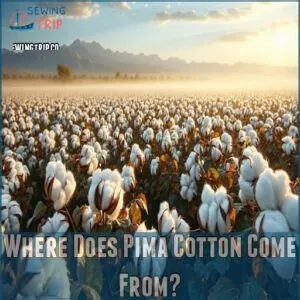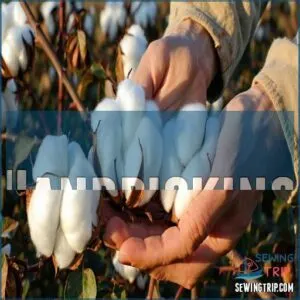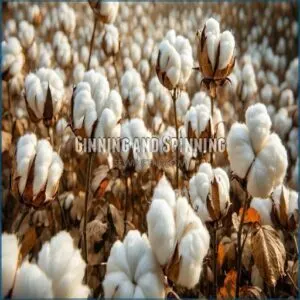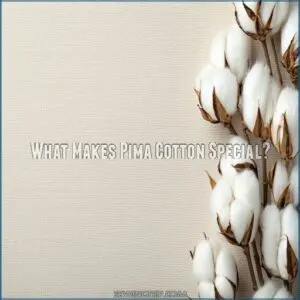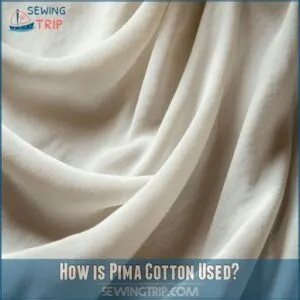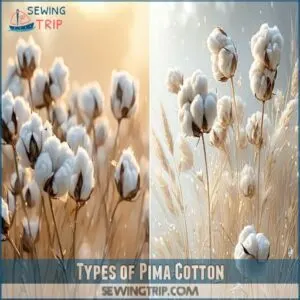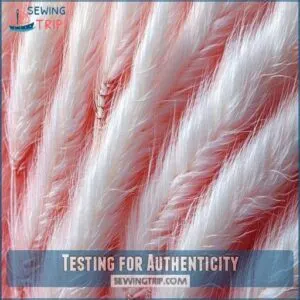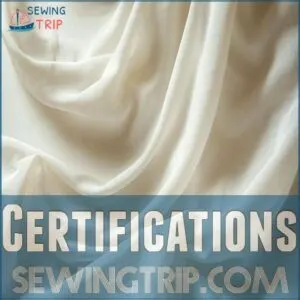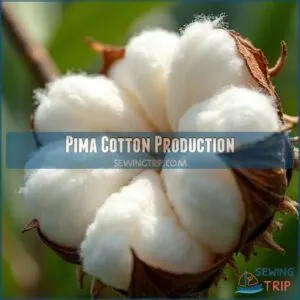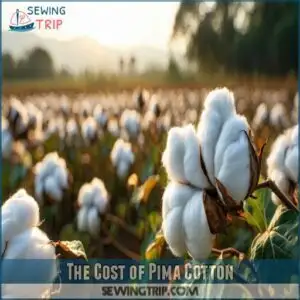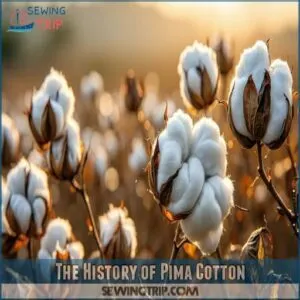This site is supported by our readers. We may earn a commission, at no cost to you, if you purchase through links.
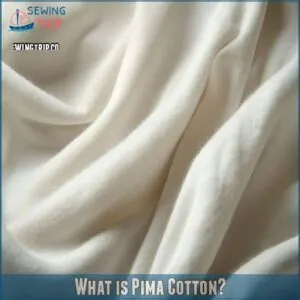
Unlike regular cotton, Pima features extra-long fibers (over 34mm) that create incredibly soft, strong, and pill-resistant materials.
It’s carefully cultivated in warm regions like California and Arizona, where ideal growing conditions and painstaking harvesting methods preserve its superior quality.
While it’s pricier than standard cotton, Pima’s exceptional durability and cashmere-like softness make it a smart investment.
But here’s the catch: not everything labeled "Pima" is authentic, and knowing how to spot the real deal can save you money.
Table Of Contents
- Key Takeaways
- What is Pima Cotton?
- Where Does Pima Cotton Come From?
- How is Pima Cotton Made?
- What Makes Pima Cotton Special?
- How is Pima Cotton Used?
- Types of Pima Cotton
- Is It Real Pima Cotton?
- Pima Cotton Production
- The Cost of Pima Cotton
- The History of Pima Cotton
- Frequently Asked Questions (FAQs)
- Conclusion
Key Takeaways
- You’ll find Pima cotton’s extra-long fibers (over 34mm) create exceptionally soft and durable fabrics that resist pilling better than regular cotton.
- You’re getting premium quality when you choose Supima cotton—it’s exclusively grown in the USA with strict quality controls and certified authenticity.
- You’ll pay more for Pima cotton products, but they’ll last 3–5 years with proper care and get softer with each wash.
- You can spot authentic Pima cotton through certifications from organizations like the ASA and USDA, as not all products labeled "Pima" are genuine.
What is Pima Cotton?
You’ll find Pima cotton’s extra-long fibers create a fabric that’s noticeably softer and stronger than regular cotton.
When you’re wearing Pima cotton clothing or sleeping on Pima cotton sheets, you’re experiencing a premium material that’s naturally more durable and silky-smooth against your skin.
Extra Long Staple Fibers
Ever wondered why your favorite luxury bedsheets feel like clouds against your skin?
It’s all about those extra-long staple fibers that make Pima cotton special.
These remarkable fibers stretch beyond 34mm, creating incredibly soft, durable fabrics that resist pilling.
Through careful handpicking and specialized processing, these premium fibers maintain their integrity, delivering that unmistakable luxurious feel that justifies their higher price tag.
Known as Sea Island Cotton
Sea Island cotton stands apart as the crown jewel of luxury fibers, with roots tracing back to South Carolina’s coastal islands.
While historically sharing DNA with Pima cotton, this rare variety yields even longer fibers than its premium cousin.
Though true Sea Island cotton isn’t commercially produced today, its legacy lives on in modern Pima cotton’s exceptional quality and ultra-soft touch.
Where Does Pima Cotton Come From?
You’ll find the finest Pima cotton growing in the warm fields of California, Texas, New Mexico, and Arizona, where it was first cultivated with help from the Pima Native Americans.
While the USA started the Pima cotton story, today you’ll also find major production in China and India, where climate conditions are perfect for growing these luxuriously long cotton fibers.
Native Americans
The rich legacy of Pima cotton begins with the skilled hands of Native American tribes in Arizona and New Mexico.
For generations, the Pima Indians masterfully cultivated this exceptional cotton variety, known for its uniquely long fibers.
Their deep understanding of the land and careful agricultural practices created what we now recognize as one of the world’s finest cotton varieties.
USA Production
Working alongside Native American communities since 1910, USA farms have mastered Pima cotton production. From Arizona’s sun-drenched fields to California’s fertile valleys, skilled farmers cultivate this premium fiber with precision, adhering to strict quality standards that have earned the United States its reputation as the birthplace of Pima cotton.
Here’s what makes American Pima production stand out:
- Advanced irrigation systems boost yields while conserving water
- Strict quality controls maintain fiber length integrity
- Sustainable farming practices reduce environmental impact
How is Pima Cotton Made?
You’ll find Pima cotton’s journey from field to fabric starts with careful handpicking to protect those precious extra-long fibers.
After harvesting, your future luxury items go through specialized ginning and spinning processes that preserve the cotton’s superior softness while creating incredibly strong yarns.
Handpicking
Skilled artisans still handpick premium Pima cotton across select fields, preserving its legendary quality, much like traditional methods used in organic and sustainable farming practices that reduce environmental impact.
Here’s how handpicking compares to machine harvesting:
| Method | Fiber Length | Quality | Cost per Pound |
|---|---|---|---|
| Handpicking | Preserved | Higher | $3.50 |
| Machine | Shortened | Lower | $1.20 |
| Hand/Machine | Mixed | Mixed | $2.35 |
| Traditional | Longest | Best | $4.00 |
This careful hand-harvesting keeps those signature long fibers intact, though it’s becoming increasingly rare in modern production.
Ginning and Spinning
After careful handpicking, your Pima cotton moves to a specialized ginning facility where advanced machinery gently separates those prized long fibers from their seeds.
For those looking to invest in this process, you can find Pima cotton ginning products at specialized suppliers like Pima cotton ginning equipment.
Modern spinning techniques transform these premium fibers into incredibly smooth, strong yarns – it’s like watching your favorite sweater being born!
Controlled humidity and expert oversight guarantee every thread maintains the superior quality that makes Pima cotton worth its luxury status.
What Makes Pima Cotton Special?
You’ll notice the difference in Pima cotton’s extra-long fibers the moment you touch them, as they’re 35% longer than regular cotton and create an incredibly soft, smooth fabric.
These premium fibers don’t just feel luxurious – they’re also stronger and more durable than standard cotton.
So your favorite Pima cotton pieces will look great even after countless washes.
Softness
The remarkable softness of Pima cotton sets it apart from ordinary fabrics.
You’ll notice it immediately – a 300 thread count Pima cotton sheet feels noticeably softer than 1,000 thread count Egyptian cotton.
Those extra-long fibers create an incredibly smooth, silky texture that gets even better with washing.
Think of it as the cashmere of cotton – it maintains that luxurious feel wash after wash, without the usual pilling or roughness.
Durability
Beyond its cloud-like softness, Pima cotton‘s remarkable durability sets it apart in your wardrobe.
These extra-long fibers create garments that stand up to life’s daily challenges:
- Superior wear resistance with minimal pilling even after years of use
- Exceptional color retention through hundreds of washes
- Natural wrinkle resistance that keeps you looking polished
You’ll find your Pima cotton pieces becoming trusted favorites, maintaining their quality wash after wash.
How is Pima Cotton Used?
You’ll find Pima cotton in luxury items that deserve the finest fabric, from premium bedsheets to high-end clothing like dress shirts and designer underwear.
When you’re ready to upgrade your wardrobe or bedroom essentials, you can’t go wrong with Pima cotton’s silky-soft touch and impressive durability.
That actually gets better with each wash.
High-End Clothing
Slipping into a Pima cotton shirt feels like wrapping yourself in a cloud of pure comfort.
This premium fabric has become the go-to choice for high-end clothing brands, crafting everything from butter-soft t-shirts to luxurious dress shirts.
Here’s what you’ll find:
| Clothing Type | Pima Cotton Use |
|---|---|
| Everyday wear | T-shirts, polos, pants. Provides comfort. |
| Formal wear | Dress shirts, suits. Luxurious texture. |
| Activewear | Workout clothes. Moisture-wicking. |
Luxury Bedding
Nothing beats sinking into luxuriously soft Pima cotton sheets after a long day.
These premium bed linens, typically featuring thread counts above 300, transform your bedroom into a five-star retreat.
You’ll appreciate how the extra-long fibers create a silky-smooth surface that’s breathable and moisture-wicking.
While they’re pricier than standard cotton, their durability and comfort make them a smart investment for quality sleep.
Types of Pima Cotton
You’ll find two main types of Pima cotton in today’s market: Supima, which is grown exclusively in the USA with strict quality controls, and organic Pima, which is cultivated without synthetic pesticides or fertilizers.
Each type offers the signature extra-long staple fibers you’ve come to expect from Pima cotton, but they’re grown and processed differently to meet specific consumer needs.
Supima
When you’re wrapping yourself in Supima cotton, you’re experiencing America’s finest cotton innovation.
For those looking to upgrade their bedding, you can find an array of Supima sheets online.
As the crème de la crème of Pima varieties, Supima’s fibers stretch 35% longer than regular cotton, creating an incredibly soft yet durable fabric.
While it commands a premium price (often triple that of standard cotton), its scientific verification, superior softness, and remarkable longevity make it a worthwhile investment.
Organic
Organic pima cotton takes luxury to new heights through sustainable farming practices that protect both you and the planet.
Building on Supima’s premium quality, the organic variety eliminates chemical pesticides and synthetic fertilizers entirely. This approach guarantees that the extra-long staple fibers (over 34mm), a hallmark of Pima cotton properties, remain unaltered and intact.
- Your skin deserves a toxin-free sanctuary
- Our planet thrives with responsible cotton farming
- Future generations inherit cleaner soil and water
The careful organic cultivation preserves pima cotton’s signature softness while supporting ethical agriculture and environmental stewardship.
Is It Real Pima Cotton?
You’ll want to verify your Pima cotton’s authenticity since not everything labeled as Pima meets the strict quality standards for extra-long staple fibers.
With certifications from organizations like ASA and USDA becoming more common, you can now easily check if you’re getting the real deal that’s worth the premium price.
Pima cotton authenticity is easily verifiable.
Testing for Authenticity
Spotting genuine Pima cotton requires more than a quick label check, especially when comparing it to other high-quality options like Egyptian cotton comparisons.
Modern testing labs use sophisticated fiber length analysis and chemical composition tests to verify authenticity.
Under a microscope, real Pima cotton reveals its signature extra-long staples, stretching beyond 34mm.
Traceability systems let you track your fabric’s journey from field to store, while supply chain audits catch any imposters trying to slip through.
Certifications
Trustworthy certifications are your best defense against fake Pima cotton in today’s market.
Supima certification verifies cotton grown by licensed American growers.
USDA certification guarantees organic growing practices, while fair trade labels confirm ethical production.
Third-party testing laboratories analyze fiber length and quality, giving you confidence that you’re getting authentic Pima cotton for your investment.
Pima Cotton Production
You’ll find most of today’s Pima cotton growing in India’s rich soil, where farmers have surpassed China as the world’s leading producer of this premium fiber.
India’s production now leads the world.
While the USA still grows Pima cotton in California, Texas, New Mexico, and Arizona, shifting climate patterns and consumer demands have pushed production eastward to meet the growing luxury textile market.
USA production continues, but is shifting.
Main Exporters
Today, India and China dominate the global Pima cotton market, having surpassed traditional producers like the USA.
India leads exports with advanced production methods and quality control, while China’s manufacturing prowess makes it a close second.
Both nations have invested heavily in testing facilities to verify fiber authenticity, offering certifications like USDA and EU organic standards that assure buyers they’re getting genuine Pima cotton.
Cultivation Challenges
Growing premium Pima cotton isn’t a walk in the park.
Unlike regular cotton, these delicate plants demand special care – from precise irrigation systems to careful pest management.
Farmers face ongoing battles with water scarcity and soil health challenges.
Climate change adds another layer of complexity, affecting growing seasons and yields. While modern techniques help, traditional hand-harvesting often remains the best way to preserve those precious extra-long fibers.
The Cost of Pima Cotton
Wondering why that Pima cotton sheet set costs more than your monthly coffee budget? You’re not alone. Pima cotton’s price tag typically runs double what you’d pay for regular cotton, but there’s solid reasoning behind the premium.
Here’s what drives those higher costs:
- Each fiber must be carefully handpicked to maintain quality
- Yields are substantially lower per acre than standard cotton
- Extra processing steps like specialized combing and carding
- Limited supply from select certified growers
- Rigorous quality control throughout production
But here’s the good news: When you factor in its legendary durability and exceptional softness, Pima cotton actually offers excellent value over time. Your investment pays off with bedding and clothing that maintains its luxury feel wash after wash.
The History of Pima Cotton
You’ll find the story of Pima cotton right here in the American Southwest, where the Pima Indians helped develop this premium cotton variety.
It’s now grown worldwide.
While it started as a small-scale crop in the early 1900s, you can now find Pima cotton in luxury items from California to China.
Though the finest varieties are still cultivated in the USA.
Ancient Cultivation
Deep within the sands of time, Pima cotton’s ancient roots stretch back to civilizations that mastered its cultivation centuries ago.
Like liquid gold flowing through ancient trade routes, these precious fibers adorned Egyptian royalty and graced Mediterranean merchants’ ships.
Early farmers developed sophisticated irrigation systems and selective breeding techniques, carefully preserving the finest cotton plants for generations to create the luxurious textile we cherish today.
USA History
The rise of Pima cotton in the USA tells a story of innovation and tradition.
Unlike other natural fibers like wool’s natural crimp, Pima cotton’s reputation is built on its softness and breathability.
Named after the Pima Indians who first mastered its cultivation, this premium cotton found its sweet spot in the American Southwest.
While ancient civilizations had their cotton varieties, the USA’s unique approach combined Native American wisdom with modern farming techniques.
By the 1800s, states like Arizona and California became powerhouses in Pima production.
Frequently Asked Questions (FAQs)
Is Pima cotton better than regular cotton?
Yes, Pima cotton’s longer fibers make it considerably better than regular cotton.
You’ll notice superior softness, durability, and a more luxurious feel.
It’s worth the higher price for items that touch your skin frequently.
What does 100% Pima cotton mean?
When you see "100% Pima cotton" on a label, it means your garment’s made entirely from premium, extra-long staple Pima cotton fibers.
no blends or other materials mixed in.
You’re getting pure luxury.
What are the disadvantages of Pima cotton?
Like a delicate silk cloud, Pima cotton’s luxury comes at a price.
You’ll pay more for garments, need gentle washing care, and might find limited style options.
It’s also prone to wrinkles and takes longer to dry.
Why is Pima cotton so expensive?
Pima cotton’s high price comes from its painstaking farming process, limited growing regions, and labor-intensive harvesting.
You’re paying for exceptionally long fibers that create softer, more durable fabrics than regular cotton.
What’s the difference between pima cotton and Egyptian cotton?
Both premium cottons offer superior quality.
They’re similar in softness and durability.
Your Egyptian cotton comes from the Nile Delta, while Pima’s grown in the American Southwest.
Does pima cotton shrink when washed?
You’ll notice minimal shrinkage in quality pima cotton when washed correctly – typically less than 3%.
Use cold water and a gentle cycle, then tumble dry on low to maintain its premium fit and feel.
Is pima cotton better for people with sensitive skin?
For sensitive skin, you’ll love how Pima cotton’s longer, smoother fibers create fewer irritating protrusions against your skin.
It’s naturally hypoallergenic and won’t trap allergens like regular cotton does, making it ideal for comfort. Pima cotton is ideal for comfort.
How long does Pima cotton clothing typically last?
With proper care, your Pima cotton clothes will outlast the pyramids!
They’ll typically serve you well for 3-5 years of regular wear, maintaining their superior softness and shape through countless washes and adventures.
Can Pima cotton shrink in the wash?
Like all cotton, Pima can shrink if not washed properly.
To protect your investment, wash in cold water and tumble dry on low heat.
Most Pima garments shrink less than 3% when cared for correctly.
Does Pima cotton need to be ironed?
You’d think premium Pima cotton needs extra care, but it’s pretty low-maintenance.
While ironing isn’t strictly necessary, a quick press on low heat can refresh wrinkles if you’re aiming for that crisp, polished look.
Conclusion
Understanding what Pima cotton truly offers can transform your textile choices.
Beyond its premium price tag lies an investment in comfort that pays dividends with every wear. Pima cotton delivers unmatched softness and durability.
Whether you’re upgrading your wardrobe or enhancing your bedding, this exceptional fabric delivers unmatched softness and durability that regular cotton simply can’t match.
Now that you know what Pima cotton is and how to spot authentic pieces, you’re ready to make informed decisions that’ll elevate your everyday comfort experience. Informed decisions and everyday comfort.

